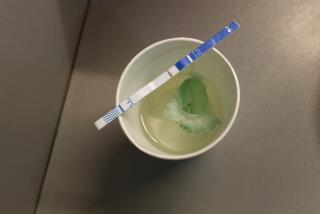Field Sobriety Test One Simple Tool
- Share via
While many people think a driver has to be falling-down drunk to be dangerous, police apply a more subtle standard.
If you can’t smoothly perform the following tasks, which are commonly required of drivers suspected of being under the influence, you stand a good chance of being arrested and hauled off to jail:
WALK AND TURN--Take nine steps heel-to-toe along a straight line with hands at your sides, then turn and take nine steps back.
ONE-LEG STAND--Stand on one foot with your hands at your sides, while raising your other foot about 6 inches off the ground for a count of at least 20 seconds.
MODIFIED POSITION OF ATTENTION--Stand with your feet together and hands at sides, then close your eyes and tilt your head back.
ALPHABET OR NUMERALS--In writing or verbally, recite the alphabet or count backwards, for example, from 89 to 65.
HAND PAT--Clap your hands, then turn one hand and clap again so that the back of the hand hits the palm. Repeat several times at a swift pace.
Officers also rely on what they call the gaze nystagmus test, which measures the ability of a suspect to smoothly track a moving object with his eyes. By moving a pen or other object back and forth, officers say they can often determine how intoxicated a person is by the jerking of his eyes.
“The tests don’t come close to simulating the complexity of driving a car,” said California Highway Patrol Officer Don Burnette. “If I guy can’t do the simple tests we give him, he surely can’t drive safely.”
But some critics contend that these “field sobriety tests” are subjective and unreliable. Many motorists, suddenly confronted by flashing lights and police officers, are so nervous that they can’t possibly succeed, they contend.
‘Can Flunk Stone-Cold Sober’
“You can flunk those tests stone-cold sober,” said Gerald Simpson, a retired Thousand Oaks chemist who has served as an expert defense witness and written several articles for the Berkeley-based DWI Journal. “They’re bogus.”
Bryant A. Villagran, the deputy public defender who oversees misdemeanor cases, agrees. “It’s voodoo in a lot of cases,” he said.
Police, however, say they take into account a range of factors before making an arrest, including a suspect’s driving pattern, general demeanor, breath odor, speech and eyes. Later, they test for alcohol in a suspect’s blood, a key piece of evidence in sealing a drunk-driving case against him.
The most common testing method, though, has been assailed by defense attorneys. Breath testers can be off by as much as 15% to 30% depending on how much a suspect has had to eat or when he had his last drink, they contend.
Even the manufacturer of the “Intoxilyzer,” widely used throughout Ventura County, acknowledges a margin of error as high as 10%.
But prosecutors, while defending the use of the machines, say such criticism misses the point. They say people should be more concerned with a person’s driving performance, not the numbers that the machine punches out.
More to Read
Sign up for Essential California
The most important California stories and recommendations in your inbox every morning.
You may occasionally receive promotional content from the Los Angeles Times.










